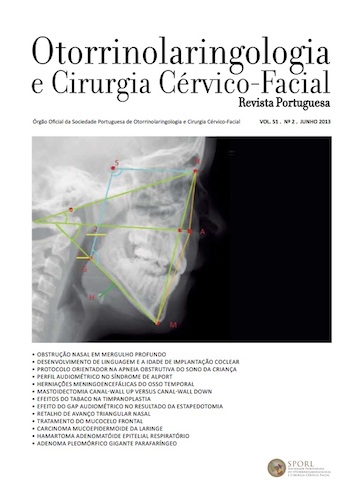Giant pleomorphic adenoma in the parapharyngeal space
DOI:
https://doi.org/10.34631/sporl.27Keywords:
Neoplasm, parotid, adenoma, pleomorphic, parapharyngealAbstract
Parapharyngeal tumours are rare. Usually they are asymptomatic but by growing they can reach compressive clinic and displacement of adjacent structures, as the case presented, with 8 cm of diameter. They are usually benign. To complete diagnosis on require a full radiological study with CT and MRI, and a cervical ultrasoundguided FNA. Initially an open biopsy is not recommended, but sometimes can be useful to achieve a diagnosis. Complete surgical excision is the treatment of choice. The approach will be chosen according to the origin, extension and pathologic characteristics. The most common are the transcervical, cervical-transparotid and transmandibular approach. As most of these tumours are benign, the best approach to be used, should be the one that involves less morbidity and less risk of recurrence for the patient. Post-operatives complications depend on the surgical approach used. Lower cranial neuropathies are the most frequent, but mostly are transient and resolve spontaneously.
Downloads
References
Hollinshead WH, editor: Fascia and fascial spaces of the head and neck. In: Anatomy for surgeons. Chapter 5. Vol.1. New York, NY; Hoeber-Harper, 1954, pp. 282-305.
Batsakis JG, Sneige N. Pathology consultation: parapharyngeal and retropharyngeal space diseases. Ann Otol Rhinol Laryngol. 1989:98:320-321.
Khafif A, Segev Y, Kaplan DM, Gil Z, Fliss DM. Surgical management of parapharyngeal space tumors: a 10-year review. Otolaryngol Head Neck Surg. 2005 Mar;132(3):401-6.
Fernandez Ferro M, Fernandez Sardoman J, Costas Lopez A, Sandoval Gutierrez J, Lopez DE, Sánchez A. Surgical treatment of benign parapharyngeal space tumours. Presentation of two clinical cases and revision of the literature. Med Oral Patol Oral Cir Bucal 2008 13:61-64.
Carrau RL, Mayer EN, Johnson JT: Management of tumours arising in PPS. Laryngoscope.1990. 100 (6):583-589.
Work W, Hybels RL. A study of tumors of the parapharyngeal space. Laryngoscope. 1974. 84:1748-55.
Som PM, Biller HF, Lawson W. Tumors of the parapharyngeal Space: preoperative evaluation, diagnosis and surgical approaches. Ann Otol Rhinol Laryngol. 1981;90 Suppl 8:3-15.
Suarez FV, Llorente JL, Gómez-Martínez J, García LA, López AF, Suárez NC. Tumores primarios del espacio parafaríngeo. Nuestra experiencia en 51 pacientes. Acta Otorrinolaringol Esp. 2009, 60(1):19-24.
Som PM, Lawson W, Sacher M, et al.: Parapharyngeal space masses: an updated protocol based upon 104 cases. Radiology. 1984, 153:149-156.
Yousem DM, Sack MJ, Scanlan KA . Biopsy of parapharyngeal space lesions. Radiology 1994, 193:619.
Rodriguez Ciurana J, Rodado C, Sáez M, Bassas C. Giant parotid pleomorphic adenoma involving the parapharyngeal space: report of a case. J Oral Maxillofac Surg. 58 :1184-1187. 2000.
Eisele DE, Netterville JL, Hoffman HT, Gantz BJ. Parapharyngeal space mases. Head Neck. 1999 Mar; 21(2):154-9.
Heeneman H. Parapharyngeal space tumours. In: Scott Brown´s Otolaryngology (Edited by: Kerr AG). Butterworth & Co Ltd 1987, 380-391.
Shahab R, Heliwell T, Jones As. How we do it: a series of 114 primary pharyngeal space neoplasms. Clin Otolaryngol 2005: 30: 364-367.
Cohen SM, Burkey BB, Netterville JL. Surgical management of
parapharyngeal space masses. Head Neck 2005: 27: 669-675.






